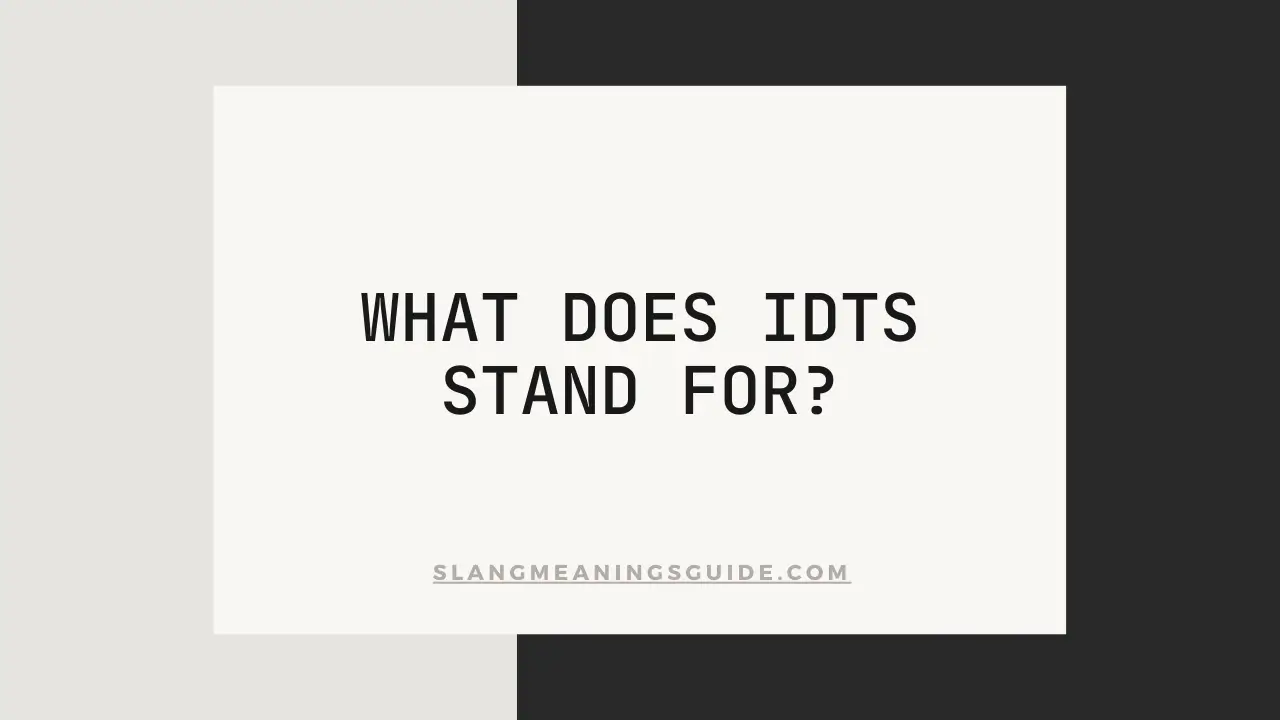| Please Wait Loading ..... |
 |

We regularly run into strange short forms, acronyms, and abbreviations in our daily conversations. One phrase that has lately gained popularity, especially in texting and social media is IDTS. Particularly with younger audiences, this casual, talkative slang has become a bit common.
IDTS stands for I Don’t Think So. It is an often used phrase to convey doubt, uncertainty, or a slight disagreement with what another person has proposed or expressed. Instead of writing out the entire sentence, people now often type IDTS to save time. Just like LOL or BRB, IDTS has also become a common abbreviation used on the internet.
IDTS has found a place in modern text communication because it allows people to quickly express doubt or uncertainty without needing to go into long explanations. In a world where quick messaging is key, shorter terms like IDTS make conversations faster and more efficient. Picture yourself in a message exchange with a friend who proposes something daring or improbable. Instead of expressing doubt, you can just use the abbreviation IDTS to convey the same meaning.
While IDTS is a casual abbreviation, there are specific situations where it works best:
Let’s take a look at some scenarios to understand how IDTS can be used effectively in real-life conversations.
Picture yourself messaging your friends and they mention seeing a well-known celebrity at the nearby grocery store. Although it is feasible, it appears doubtful.
Friend: Guess what! I saw Jennifer Lopez at our grocery store today!
You: IDTS, that sounds too good to be true!
Here, by using IDTS, you gently express doubt without completely dismissing your friend’s excitement. It’s a friendly way of showing disbelief.
One buddy suggests conquering a difficult mountain climb when you and your buddies are organizing a weekend trip. Given the group’s different physical capabilities, you’re not sure whether it’s a smart idea.
Friend: Let’s hike up that huge mountain! It’ll be so cool!
You: IDTS, maybe we should start with an easier trail.
In this case, you use IDTS to show that you’re not entirely convinced about the plan. It lets you politely push for a safer alternative without sounding negative.
You’re hanging out with friends when someone suggests slipping into a fancy event without paying for tickets. You are uneasy about the concept and prefer to avoid any potential impact.
Friend: Come on, let’s just sneak in! Nobody will notice!
You: IDTS, I’m not risking it.
Here, IDTS acts as a quick and easy way to express your disapproval. You’re making it clear that you don’t agree with the idea without arguing.
A friend tells you they plan to quit their job and travel the world without any savings. While you admire their ambition, it seems unrealistic.
Friend: “I’m going to quit my job next month and just travel!”
You: “IDTS, have you thought this through?”
Using IDTS here allows you to bring up your concern in a friendly, non-judgmental way, giving your friend a gentle nudge to consider the consequences of their decision.
The rise of IDTS and similar abbreviations can be attributed to the nature of online and text-based conversations. Here are a few reasons why IDTS is so widely used:
IDTS may be puzzling for those who are not familiar with internet slang. Confusion may arise if a person fails to realize it is short for I don’t think so. If you use IDTS in a formal situation or with someone not familiar with technology, they could mistake it for random letters or not comprehend your reply.
Tip: When you’re texting someone who is not familiar with you, speak the whole situation rather than just using online lingo or acronyms to avoid misunderstandings
IDTS is just one of many abbreviations that convey disagreement or doubt. Here are a few similar ones that people use in text conversations:
While these terms don’t mean the exact same thing as IDTS, they all serve to communicate opinions, doubts, or disagreements in a compact form.
To use IDTS effectively in your conversations, keep these tips in mind:
The next time someone proposes something that doesn’t feel right, consider using IDTS to express your views. This is an easy and efficient method of keeping the conversation going while also ensuring you remain connected in a friendly and non-confrontational manner.
Comments